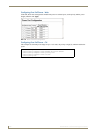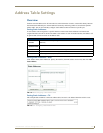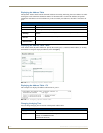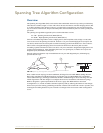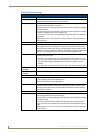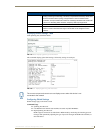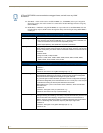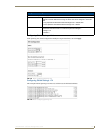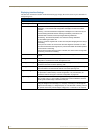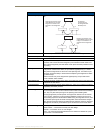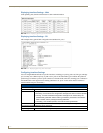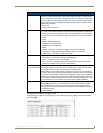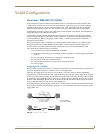
Spanning Tree Algorithm Configuration
116
NXA-ENET24 - Software Management Guide
STP Mode – If the switch receives an 802.1D BPDU (i.e., STP BPDU) after a port’s migration
delay timer expires, the switch assumes it is connected to an 802.1D bridge and starts using only
802.1D BPDUs.
RSTP Mode – If RSTP is using 802.1D BPDUs on a port and receives an RSTP BPDU after the
migration delay expires, RSTP restarts the migration delay timer and begins using RSTP BPDUs
on that port.
STP and RSTP BPDUs are transmitted as untagged frames, and will cross any VLAN
boundaries.
Command Attributes - Basic Configuration of Global Settings
• Spanning Tree State Enables/disables STA on this switch. (Default: Enabled)
• Spanning Tree Type Specifies the type of spanning tree used on this switch:
• STP: Spanning Tree Protocol (IEEE 802.1D; i.e., when this option is selected, the
switch will use RSTP set to STP forced compatibility mode)
• RSTP: Rapid Spanning Tree (IEEE 802.1w) RSTP is the default.
•Priority Bridge priority is used in selecting the root device, root port, and designated port. The
device with the highest priority becomes the STA root device. However, if all devices
have the same priority, the device with the lowest MAC address will then become the
root device.
• Default: 32768
• Range: 0-61440, in steps of 4096
• Options: 0, 4096, 8192, 12288, 16384, 20480, 24576, 28672, 32768, 36864,
40960, 45056, 49152, 53248, 57344, 61440
Command Attributes - Root Device Configuration
• Hello Time: Interval (in seconds) at which this device transmits a configuration message.
• Default: 2
• Minimum: 1
• Maximum: The lower of 10 or [(Max. Message Age / 2) -1]
• Maximum Age: The maximum time (in seconds) a device can wait without receiving a configuration
message before attempting to reconfigure. All device ports (except for designated
ports) should receive configuration messages at regular intervals.
Any port that ages out STA information (provided in the last configuration message)
becomes the designated port for the attached LAN. If it is a root port, a new root port
is selected from among the device ports attached to the network.
Note: References to “ports” in this section mean “interfaces,” which includes both
ports and trunks.
• Default: 20
• Minimum: The higher of 6 or [2 x (Hello Time + 1)].
• Maximum: The lower of 40 or [2 x (Forward Delay - 1)]
• Forward Delay: The maximum time (in seconds) this device will wait before changing states (i.e., dis-
carding to learning to forwarding). This delay is required because every device must
receive information about topology changes before it starts to forward frames. In
addition, each port needs time to listen for conflicting information that would make it
return to a discarding state; otherwise, temporary data loops might result.
• Default: 15
• Minimum: The higher of 4 or [(Max. Message Age / 2) + 1]
• Maximum: 30



